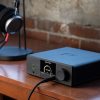Hack #39 from Home Theater Hacks by Brett McLaughlin (O’Reilly Media).
Speaker manufacturers are enticing more and more consumers to go with small, mini-, or micro-speakers for even the front and center channels. Although these speakers might look great, they just can’t do what the large speakers can do.
These days, many home theater speaker systems feature very small speakers for the front, center, and surround channels. This has the advantage of allowing you to fit a home theater into a closet, if you should happen to use one as your viewing room. Such small speakers also are very unobtrusive and can be more acceptable to other family members. However, if you check carefully into the specifications for what is actually tucked inside those small speaker enclosures, you might find only one small (like two inches!) speaker.
Although that might not sound like a big deal, remember that one small speaker is being asked to cover all the frequencies from where the speaker system’s subwoofer stops, on up to the very top frequencies delivered by your system. Due to their small physical size, these small speakers will not do a good a job of delivering real power at midrange frequencies, let alone the extreme edges of its range (the lowest lows the speaker is asked to handle, and the highest highs).
Some manufacturers design these little speakers with “long throw” capability, which will help them move a little more air for their size. Still, the best analogy I can think of is comparing a big, powerful, eight-cylinder car doing 90 mph to a little, four-cylinder economy car trying to go the same speed. The automobile with the big engine will be cruising along, while the little car will be thrashing as hard as it can just to keep up! Sure, the Volvo looks good, but it’s just not going to get you where you’re going as fast as the car with the big engine. The same is certainly a good (albeit imperfect) analogy for many of the micro-speaker sets that are in vogue these days.
In addition, bigger speakers usually have at least one tweeter while smaller speakers don’t. Tweeters are specifically designed to perform well at the high frequencies, and easily outperform small speakers trying to be all things to all people. So, now you’ve lost some high-end quality and some midrange quality. Guess what’s next on the “not as good” list. Yup: the lows don’t sound as strong, either.
The home theater speaker manufacturer might try to make up for the lack of low end in the little speakers by designing a “matched” subwoofer to work at frequencies up to 120 Hz, 150 Hz, or even higher! This subwoofer essentially becomes required buying if you go with the smaller speaker set. If you check the frequency range of such subwoofers, though, you might find that although they can play some higher frequencies, they end up bottoming out around 40 or 50 Hz, which doesn’t make for much deep bass. Besides, who wants the main sounds of a movie to come out of the subwoofer in the first place?
Further, another difficulty arises from allowing the subwoofer to handle frequencies above 80 Hz. As you move upward in frequency from 80 Hz, it becomes easier to tell where a sound is coming from. Below 80 Hz, it is much harder to tell where a sound comes from. This allows a subwoofer that doesn’t produce frequencies above 80 Hz to be located where it is convenient [Hack #50], or where it makes for the best bass [Hack #52]. This is why Lucasfilm’s THX standard uses 80 Hz as the crossover point between the subwoofer and the rest of the speakers in the system. It allows for varied placement of the sub, and it lets the sub focus on what it should do best: produce bass.
If your system uses a crossover frequency much higher than 80 Hz, make every effort to put the subwoofer right near the television, so the illusion that the sound is coming from the screen is maintained even at the higher subwoofer frequencies. If the home theater speaker set manufacturer is careless, or cares more about delivering deep bass, the subwoofer supplied might not reach “up to” the frequency where the little speakers start to be able to produce a useful signal. The result is a hole between the top end of the subwoofer frequency range and the bottom end of the little speaker’s frequency range. Low male voices will sound thin, and music with low to midrange frequencies also will be weak.
Most likely, this hole will lie between 100 and 150 Hz.
Because our hearing is so adaptable, many folks can listen to home theater speaker systems with small speakers and not know what they’re missing. Before you purchase a home theater system using small speakers, listen to the same movie or music on a good home theater speaker set where each center and front speaker has at least a four-inch diameter midrange speaker — in addition to at least one tweeter. Then compare that sound to what you hear on the small speakers. This way you will be aware of all the trade-offs in using small speakers.
— by David Gibbons

This material has been adapted from Home Theater Hacks by Brett McLaughlin, published by O’Reilly Media, Inc. Copyright O’Reilly Media, Inc., 2005. All rights reserved.
A smart collection of insider tips and tricks, Home Theater Hacks covers home theater installation from start to finish, purchase to experience. Just imagine: no frustrating trial and error process and better yet, no expensive appointments with installation experts. Home Theater Hacks prevents both by imparting down-and-dirty technique not found anywhere else.
Home Theater Hacks is available for purchase from Amazon.com, Amazon.co.uk, and Amazon.ca.
See more Home Theater Hacks:
Learn how to level match your speakers with a sound meter
Set large speakers as “small” on your A/V receiver






























